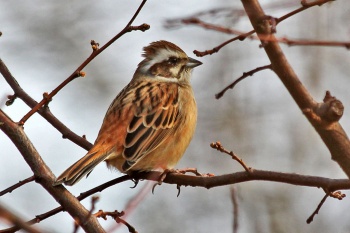- Emberiza cioides
Identification

Photo © by letsbefrank
Tonboike Park (Dragonfly Pond Park), Kishiwada, Japan, 20 January 2013
Also known as Siberian Meadow Bunting. 17 cm (6¾ in)
- Chestnut crown
- Broad white supercilium
- White moustachial stripe and throat
- Grey neck sides and throat
- Reddish-brown upperparts with dark streaks
- Rufous rump
- White outer tail-feathers
- Pinkish-brown legs
Females are similar but are duller and paler with a less well-defined head pattern.
Distribution
Siberia, northern and eastern China, eastern Kazakhstan, Kyrgyzstan, Mongolia, Korea and Japan.
Taxonomy
Subspecies
There are 5 subspecies[1]:
- E. c. tarbagataica:
- E. c. cioides:
- North West Altai Mountains to Transbaikalia and mountains of Mongolia
- E. c. weigoldi:
- E Transbaikalia to Manchuria, northern Liaoning and northern Korea
- E. c. castaneiceps:
- South and central Korea and eastern China
- E. c. ciopsis:
- South Kuril and Japanese islands; winters from Honshu southward
Habitat
They can be found in a variety of lightly wooded rolling hills and mountain foothills; woodland edges, rocky slopes. Riversides, rice paddies, reeds, weeds and thickets.
Behaviour
Diet
Their diet consists mostly of seeds from grass and weeds, with the addition of invertebrates (generally in the summer). They mostly feed on the ground.
Breeding
Monogamous. The nest is a cup constructed from rootlets and grass. It is built entirely by the female and placed on or near the ground in low bushes. The clutch contains 3-5 eggs which are incubated for 11 days. The young birds fledge after another 11 days.
Vocalisation
The song is a short, hurried phrase given from a prominent perch. The call is a series of up to four sharp notes.
Listen to Meadow Bunting sound clip
Lone male
Recording © by Aladdin
Miyake Island, Miakejima, Japan, April 2019
References
- Clements, J. F., T. S. Schulenberg, M. J. Iliff, D. Roberson, T. A. Fredericks, B. L. Sullivan, and C. L. Wood. 2018. The eBird/Clements checklist of birds of the world: v2018. Downloaded from http://www.birds.cornell.edu/clementschecklist/download/
- Madge, S. (2019). Meadow Bunting (Emberiza cioides). In: del Hoyo, J., Elliott, A., Sargatal, J., Christie, D.A. & de Juana, E. (eds.). Handbook of the Birds of the World Alive. Lynx Edicions, Barcelona. (retrieved from https://www.hbw.com/node/61866 on 9 April 2019).
- Birdforum Member observations.
- Byers, C., J. Curson, and U. Olsson. (1995) Sparrows and Buntings: A Guide to the Sparrows and Buntings of North America and the World. Houghton Mifflin, Boston.
Recommended Citation
- BirdForum Opus contributors. (2025) Meadow Bunting. In: BirdForum, the forum for wild birds and birding. Retrieved 25 April 2025 from https://www.birdforum.net/opus/Meadow_Bunting




